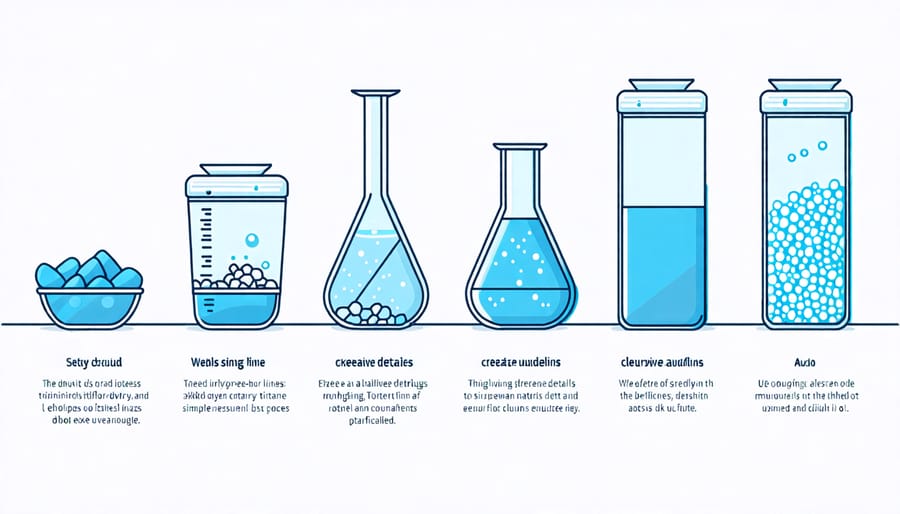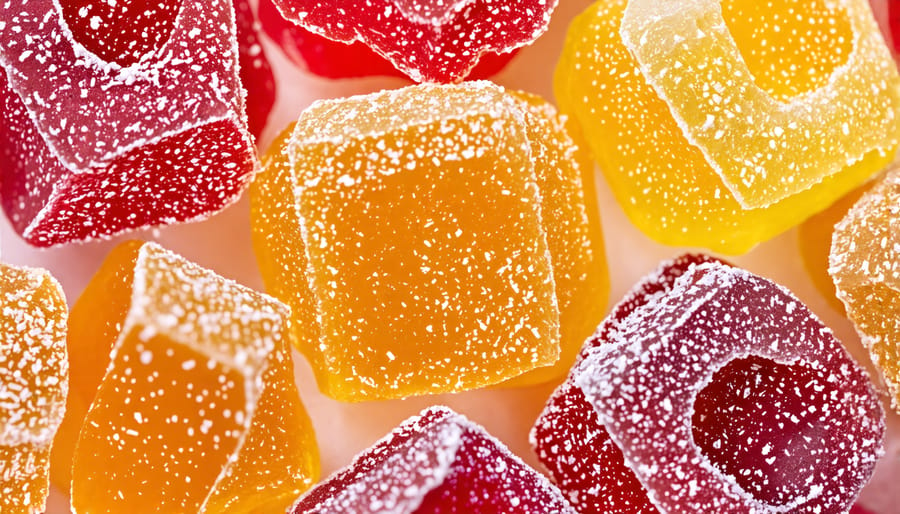
The Intriguing Chemistry Behind Freeze-Dried Candy: A Sweet Science
The science behind freeze-dried confections represents a fascinating intersection of chemistry and culinary innovation. While companies like berry candy have popularized these unique treats, the complex chemical processes involved in transforming regular candies into their freeze-dried counterparts deserve closer examination. This article delves into the intricate chemistry behind freeze-drying technology, exploring how this preservation method revolutionizes texture, enhances flavor, and extends shelf life while maintaining the integrity of our favorite sweets.
Understanding the Freeze-Drying Process
What is Freeze-Drying?
Freeze-drying, scientifically known as lyophilization, is a dehydration process widely utilized in preserving both food and pharmaceuticals. It involves freezing the material, reducing the surrounding pressure, and then removing the ice through sublimation, in which solid ice converts directly to vapor without passing through a liquid phase. This meticulous process effectively preserves the structural integrity and nutritional content of products, making it ideal for delicate substances such as fruits and candies. From a chemical perspective, freeze-drying minimizes the degradation reactions that occur in the presence of liquid water, such as hydrolysis and microbial growth, thus extending shelf life significantly.
In recent years, Canadian advancements in sustainable chemical technologies have further innovated the freeze-drying process, focusing on energy efficiency and reduced environmental impact. This aligns with the growing emphasis on sustainability within the chemical industry, ensuring that such processes not only meet industrial needs but also adhere to environmental standards. For researchers and professionals interested in the chemistry of confectionery preservation, understanding the scientific intricacies of freeze-drying is integral to developing new products that emphasize quality and longevity.
The Phases of Freeze-Drying
Freeze-drying candies involves a fascinating transformation through three critical phases: freezing, primary drying, and secondary drying. Each phase plays a crucial role in preserving the candy’s texture and taste while ensuring its shelf stability.
During the freezing phase, the water content within the candy is solidified by lowering the temperature, forming ice crystals. This essential first step requires precise control to prevent large ice crystals from damaging the candy’s delicate structure. Proper freezing sets the stage for efficient sublimation—the transition of ice directly into vapor—that occurs in the subsequent phase.
The primary drying phase, or sublimation, involves reducing the pressure and slightly increasing the temperature to allow ice to transition directly into vapor without passing through the liquid phase. This phase is critical as it removes 95% of the water content. The chemical implication here is the preservation of volatile compounds and the prevention of chemical reactions that could alter flavors. Advances in Canadian freeze-drying technology have improved the efficiency of this phase, reflecting a national commitment to sustainable practices.
Finally, the secondary drying phase targets the residual water molecules bound to the candy’s structure. By further lowering the pressure and raising the temperature, these molecules are removed. This phase ensures long-term stability and prevents spoilage. Overall, the chemistry of freeze-drying not only enhances the durability and quality of candies but also represents a significant stride toward sustainable food processing solutions. Connect this with Canada’s significant focus on methods to mitigate sustainability challenges for broader industrial applications.

Chemical Reactions in Freeze-Drying Candy
Impact on Sugar and Flavor Compounds
During freeze-drying, candies undergo a transformation that significantly affects their sugar and flavor compounds, pivotal to both their taste and texture profiles. The process involves freezing the candy and then reducing the surrounding pressure to allow the frozen water to sublimate directly from a solid to a gas. This sublimation is gentle on the sugars, primarily sucrose and glucose, minimizing their breakdown and preserving their sweetness. The retention of these sugars is crucial, as it maintains the candy’s structural integrity and energy content.
When focusing on flavor compounds, freeze-drying is remarkably effective at retaining volatile molecules responsible for the candy’s taste and aroma due to the low temperatures used, which prevent heat-induced reactions. This preservation results in a more potent flavor profile compared to traditional drying methods. Canadian researchers have contributed to optimizing freeze-drying techniques to enhance the preservation of these delicate compounds, underscoring the importance of sustainability in the chemical industry.
In summary, freeze-drying candies effectively maintains their sugar content and preserves complex flavor compounds, ensuring that the final product remains as flavorful and enjoyable as its fresh counterpart. This process aligns with sustainable practices by reducing energy consumption inherent in conventional drying methods, showcasing Canada’s advancements in chemical technology.

Physical Changes: From Texture to Preservation
Freeze-drying, or lyophilization, significantly alters the texture and preservation characteristics of candies by removing moisture while maintaining structural integrity. This process begins by freezing the candy, causing water molecules to become ice crystals. During the subsequent sublimation phase, these ice crystals transform directly into vapor under low pressure, bypassing the liquid stage. This crucial step eliminates over 98% of the moisture content, crucial for inhibiting microbial growth and enzymatic reactions that cause spoilage.
The physical transformation intensifies the candy’s texture, changing chewy treats into crispy, airy delights. Without the binding presence of water, the crystallized ingredients are left to shine, often enhancing flavor concentration and providing a more intense, intriguing taste experience. Furthermore, the reduction in water activity ensures an extended shelf life, making such candies more viable in the commercial market without requiring preservatives.
Canada has been at the forefront of innovative freeze-drying techniques, advancing sustainability in the chemical industry. Canadian researchers have focused on optimizing energy usage and reducing environmental impacts, key in promoting eco-friendly practices. Freeze-dried candies exemplify a meeting point between texture innovation and preservation, offering a unique case study in practical chemistry that aligns with sustainable goals.
Innovations and Canadian Contributions
Advancements in Freeze-Drying Technology
Recent advancements in freeze-drying technology have significantly improved the efficiency and outcomes of this fascinating process, especially in the production of candies. Innovations such as improved vacuum systems and optimized temperature control allow for more precise manipulation of sublimation, ensuring better preservation of the original flavor and texture profiles of candies. These technological improvements minimize energy consumption, reflecting a commitment to sustainability within the industry, and reducing overall environmental impact.
In Canada, researchers have spearheaded developments in cryoprotectant formulations that enhance the stability of freeze-dried products, contributing to longer shelf-life and improved quality. The use of advanced computational modeling to analyze the drying kinetics has further enhanced the predictability and efficiency of freeze-drying operations. To appreciate how these advancements parallel computational approaches in other sciences, consider the synergy seen in the connection between forest science and artificial intelligence. By integrating these state-of-the-art techniques, the candy industry can achieve a superior end product while maintaining alignment with the growing emphasis on environmentally conscious practices.
This progress not only benefits the candy industry but also underscores the broader potential applications of freeze-drying technology across various sectors, demonstrating its vital role in modern scientific and industrial landscapes.

Canadian Innovations in the Field
Canadian researchers have significantly contributed to the advancement of freeze-drying candy technology by combining chemical insights with practical applications. Notably, Canadian innovators have leveraged their expertise to enhance the efficiency and sustainability of the freeze-drying process. By optimizing the sublimation phase, where ice transforms directly into vapor, these scientists have managed to reduce energy consumption, aligning with the broader goals of sustainability in the chemical industry. Furthermore, Canadian industries have pioneered methods to preserve the flavor and nutritional content of candies, ensuring they remain appealing while minimizing resource use. This balance between innovation and environmental responsibility underscores Canada’s role in leading advancements in food chemistry. Such contributions not only reflect a profound understanding of the chemical dynamics involved but also emphasize the importance of sustainable practices in industrial applications. Through these efforts, Canada continues to bolster its reputation as a hub for cutting-edge science and responsible innovation, inspiring the global community of students, researchers, and professionals in this dynamic field.
The Future of Freeze-Dried Candy
As the freeze-drying process gains popularity in the confectionery industry, it is likely to play a significant role in shaping the future of candy production. One of the most promising aspects of freeze-dried candy is its potential to support sustainable practices within the industry. By reducing the need for preservatives and extending shelf life, freeze-drying can help minimize food waste and reduce the environmental impact of candy production. Additionally, freeze-drying allows for the use of natural ingredients, such as real fruit, which aligns with the growing consumer demand for healthier and more natural confectionery options. As technology advances, we can expect to see more innovative applications of freeze-drying in candy production, such as the development of new textures, flavors, and functional ingredients. Moreover, the ability to preserve the nutritional value of ingredients through freeze-drying opens up possibilities for the creation of nutrient-dense candies that offer both indulgence and health benefits. As Canada continues to face sustainability challenges, the confectionery industry has an opportunity to leverage freeze-drying technology to create products that are not only delicious but also environmentally friendly and socially responsible. By embracing freeze-drying as a means to promote sustainability, the Canadian confectionery industry can position itself as a leader in the global market while contributing to a greener future for all.
Conclusion
In conclusion, the chemistry of freeze-drying candy is a fascinating process that integrates principles from thermodynamics, phase transitions, and molecular interactions. By understanding the key stages of freezing, primary drying, and secondary drying, chemists and confectionery professionals can optimize the process to create high-quality freeze-dried candies with extended shelf life and unique textures. The preservation of nutritional value and flavor compounds through freeze-drying highlights its significance in the food industry. Moreover, Canadian researchers and companies have made notable contributions to the advancement of freeze-drying technology, emphasizing sustainability and energy efficiency. As the demand for innovative and convenient snack options grows, the freeze-drying process will continue to play a crucial role in the confectionery industry. However, unanswered questions remain regarding the optimization of freeze-drying parameters for specific candy formulations and the potential for novel applications. Further research and collaboration between chemists and industry professionals will undoubtedly lead to exciting developments in this field.


